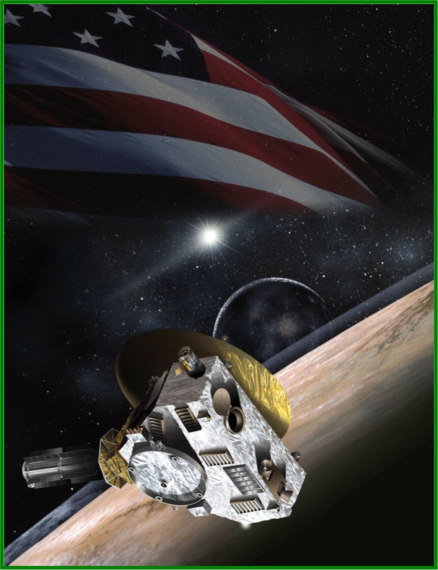Last week we all marveled at the historic first landing on the surface of a comet as Philae, dispatched from the Rosetta spacecraft, began science operations on a slowly warming comet (before going into indefinite hibernation for lack of sunlight).
Now further excitement awaits for Solar System research: The New Horizons spacecraft, en route to Pluto and its system of moons since 2006, will reach a critical milestone on December 6. On that day the spacecraft, set to be the first to explore the distant planet -- or dwarf planet, depending on your belief -- will come out of hibernation mode. This marks the first step in setting up for the flyby of Pluto and its moons that will occur on July 14, 2015, giving us our first-ever close-up look at Pluto and its large moon Charon, along with four other small moons -- Hydra, Nix, Kerberos, and Styx.
Credit: New Horizons Mission
Alan Stern, Principal Investigator for New Horizons, excitedly describes how the spacecraft will soon be "on Pluto's doorstep." Pluto lies more than 30 astronomical units (AU) from Earth at present -- that's 30 times the distance between Earth and the Sun, which is some 93 million miles (150 million km). The spacecraft, moving slowly, is now a mere 1.9 AU from Pluto, with just eight months to go.
When the craft flies past the Pluto system, it will give us the first-ever thorough look at what many consider to be the last great frontier of the Solar System.
Pluto continues to both attract enormous affection from the astronomical community and continue its day in the spotlight of controversy. In 2006 a small group inside the International Astronomical Union, meeting in Prague, decided to vote on a new definition of the term "planet" and voted Pluto out of planethood, redefining it as a dwarf planet, along with the asteroids Ceres, Haumea, Eris, and Makemake.
In early 2014 I had the pleasure of attending a lecture in New York by Stern, who made several salient points about the Pluto controversy. A house is a house whether it stands in the city or countryside. Shouldn't a planet be a planet regardless of where it exists? At the Pluto-like distance of 30 AU, Earth would not clear its orbit of asteroids, one of the requirements from the IAU for planethood. So would Earth then not be classified as a planet? Planetary scientists have scratched their heads about this, remarking that stars are stars wherever they exist -- and stars can orbit stars, in fact. Some astronomers even openly consider very large moons like Ganymede and the Moon planets as well and have posed the question (in Stern's words) "If stars can orbit stars, why can't planets orbit planets?"
Regardless of where you come down on the nomenclature, Pluto and its moons represent a very exciting system of worlds that has never been explored. We are reaching a critical moment in another huge, and very historic, chapter in the exploration of space. Stay tuned -- excitement awaits!
I have written extensively about Pluto, what we know prior to the New Horizons flyby, and the Pluto controversy, in my forthcoming Cambridge University Press book, The New Cosmos: Understanding Astronomy's Big Questions, due for release in fall 2015.
